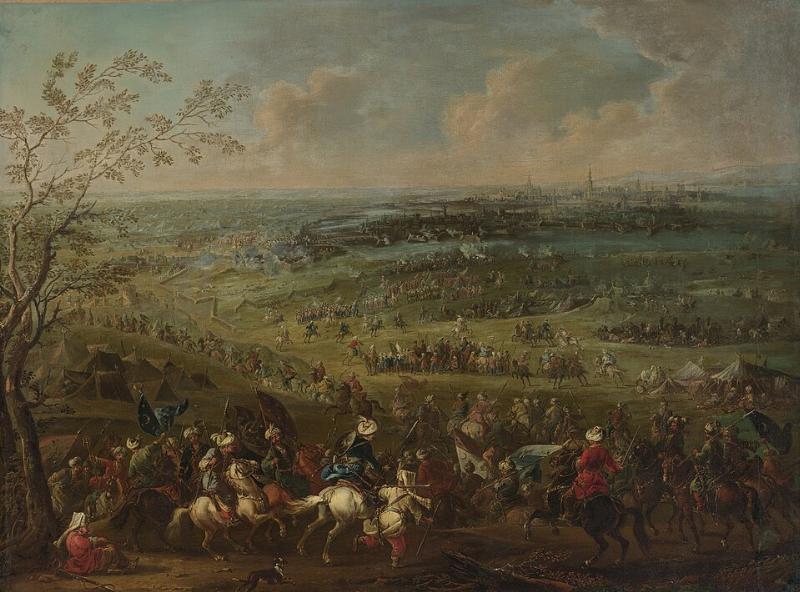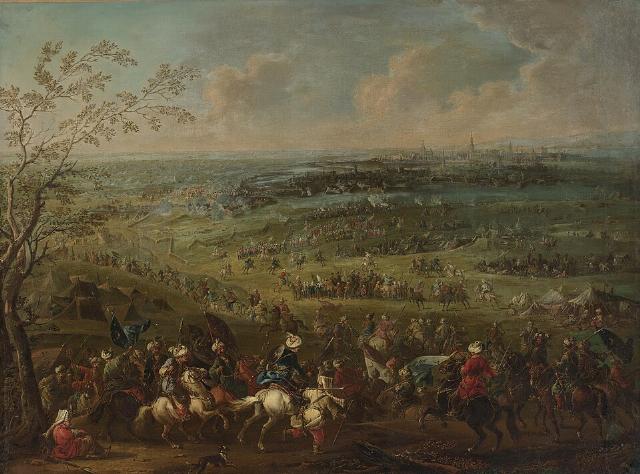



Image from Wikipedia Commons: The Turkish Siege of Vienna (August Querfurt, 1750s)
Kahlenberg is a hill outside Vienna. Known for its panoramic views of the capital, a peaceful vantage point covered with groves and vineyards, it is a favorite day trip destination for loving couples and families with small children. Nothing in this idyll, except a modest plague dedicated to Polish King John (Jan) III Sobieski, bears witness to the fateful drama that unfolded here on September 12, 1683.
It is said that the Islamic advance beyond the Bosphorus Strait finally came to a halt at the gates of Vienna. For centuries, Ottomans had enjoyed nearly unbroken military success, conquering Christian territories in Anatolia and the Balkans. Initially, they bypassed the Byzantine capital, Constantinople, only to gather forces and storm the Theodosian Walls in 1453, finally capturing the dilapidated remains of the metropolis. The desecration of Hagia Sophia was a temporary low point in the history of Christendom. In 1683, however, the turn seemed to have come for Catholic Vienna.
The Battle of Vienna followed a two-month siege of the city. On one side stood the Holy Roman Empire in alliance with the Polish-Lithuanian Commonwealth, on the other side the Ottoman Empire. That the battle did not result in another catastrophe for Christendom is rightfully attributed to the heroic intervention of the Poles. In recognition of his historical importance, it would have made perfect sense to erect a memorial in honor of the Polish king who commanded the Christian forces.
As far back as 2013, Polish president Bronislaw Komorowski actually proposed a monument commemorating Sobieski and his relief army on Kahlenberg. Despite widespread enthusiasm for this idea in both Poland and Austria, however, the realization process would prove to be long and painful.
For a start, in agreement with the city government of Vienna, workers built a solid pedestal on the site. Appointed to design a statue, Polish professor Czeslaw Dzwigaj, Academy of Fine Arts in Krakow, concomitantly set out to produce a deeply personal work characterized by chaotic drama and pace. The plan was for his sculpture to be placed on its pedestal and revealed to the public in 2018 on the 335th anniversary of the battle.
Shortly before the delivery of the monument in 2018, however, Michael Ludwig, socialist mayor of Vienna, announced the decision of his city government to withdraw its consent to the plan, citing concerns about the design.
Then, on November 8, 2024, the case was apparently closed once and for all. Veronica Kaup-Hasler, culture councilor of the city government, thus went on to irrevocably abandon the Polish monument plans on Kahlenberg, arguing as follows: “Vienna will not erect a stage which can be abused for xenophobic agitation and for fomenting Islamophobia and anti-Turkish sentiment”.
Outraged by the unpatriotic, opportunistic, and treacherous machinations of the city government, national conservative intellectuals have openly accused socialist councilors of pandering to Muslim voters. Just like in the rest of Western Europe, the latter form a rapidly growing interest group with influence on institutions, sociocultural practices, and installations in public space.
In Vienna, as many as 41.2% of students in primary and middle schools identify as Muslim (compared to 34.5% Christians). This stunning observation renders Muslims the largest religious group in the public school system of the Austrian capital. Indisputably the rulers of tomorrow, as they have been for centuries in Constantinople, though only a numerical majority in that place for a hundred years, Muslims presently constitute 14.8% of the total urban population.
Turks are done lurking outside the city gates of Vienna. Thanks to narrow-minded greed in conjunction with Western self-hatred (demanding “cheap labor” and “diversity”, respectively), they have long since been let in. Islamic polarization and nationalist herd mentality are whetting their appetite for takeover. Among natives, there is an uneasy atmosphere of doom. Nobody with their senses intact has reason to doubt the ominous transformation that is taking place in these years.
Although profound, changes have been insidious and may consistently be denied by those acting in bad faith. However, disturbing realities cannot be ignored any longer: Immigrants increasingly dominate urban life in Vienna. A late realization for oriental exoticists and other romantics, who unconsciously long for “deliverance in bondage”, changes are visible in so many other ways than the proliferation of Asian fruit markets, hookah bars, and lokantas.
Thus, if there is a football match involving teams from their homeland or a high-profile wedding in their ethnic community, military-age Turks drive rampant through the streets. Like another show of force, noisy motorcades disrupting traffic reinforce the suspicion that they are above the law. Throughout the year, however, gangs of young immigrants (e.g. Arabs, Afghans, Somalis) patrol public space after dark, harassing natives in supremacist-callous ways. (The same dismal picture characterizes other cities across the EU and the UK.)
Without affection or respect for natives, Turkish nationalists do whatever suits them as if they were conquerors, utterly contemptuous of Western decadence and docility. Al Bayrak with the crescent moon and star hangs from their windows. To be sure, their unmistakably dominant behavior shows their sense of ownership of Vienna.
Indeed, fueled by their faith and the awareness of historic victories on the battlefield, Turks clearly perceive the weakness of the indigenous population and are confident of ultimate hegemony. They know very well that the future belongs to them. From the perspective of eternity, the Battle of Vienna in 1683 was nothing more than a parenthesis. Muslims have learned from their experiences and are returning with a vengeance. Nothing can stop them this time round. They continue to immigrate as well as multiply in unlimited numbers. Meanwhile, natives watch in silence and bewilderment. (Experience suggests that the treacherous alliance of socialists and Islamists will be short-term.)
Before long, immigrants will own the ancient city of Vienna — and the rest of Austria for that matter. Conversely, the descendants of those, who in 1683 fought to the death for their national sovereignty and faith, have already given up their dignity and morality. Victims of a secular identity crisis and embracing fatalism for lack of better, they prepare for submission, hoping for mercy. Over time, they will have to get used to living as second-class citizens. Neither self-denying charity nor cowardice affords protection against the sworn enemy of Christendom.
A monument as originally planned for the 1683 victor on Kahlenberg might have been a timely reminder to Europeans that they should take their fate into their own hands rather than allow themselves to be intimidated and subjugated.
Unlike Poland and Hungary, which solemnly acknowledge their own past, Western Europe is at a crossroads. There is a remarkable struggle over symbols. Of course, it is fundamentally about identity, religious and national. The Polish monument on Kahlenberg is one example. Another example was the dispute over the cross atop the dome of the rebuilt Berlin Palace (under the name “Humboldt Forum”) in 2017. Unsurprisingly, hostile opposition to Christian symbolism was formulated by socialists whose Stalinist comrades in the GDR blew up Schlüter’s baroque masterpiece in 1950.
Jesus, by his own example, taught us love, generosity, and tolerance. However, he never demanded that his followers behave like fools and be enslaved by evil plotters. Accordingly, we should not be blinded by our own zeal for goodness and allow those, who exploit our gullibility, to oppress us without mercy as soon as conditions allow. Put another way, Jesus never encouraged anything like “suicidal empathy”. In stark contrast to the political conspirators of our time, who hand over their children to oppression and slavery, he was genuinely courageous — allowing himself to be tortured and crucified for his faith rather than deny his heavenly father or flee.
In Europe, they face the end with their eyes wide open. To truly protect the tolerance characteristic of the “open society”, arguably the pinnacle of Western civilization, an enlightened, rules-based community based on Judeo-Christian values, they should have fought intolerance in all its forms and with all their might. This is especially true when evil appears in disguise, hypocritically preaching the salvation of mankind while, in reality, representing a totalitarian ideology in conflict with liberty, crushing human life and happiness.
“The enemy is within the gates; it is with our own luxury, our own folly, our own criminality that we have to contend.” — Marcus Tullius Cicero
